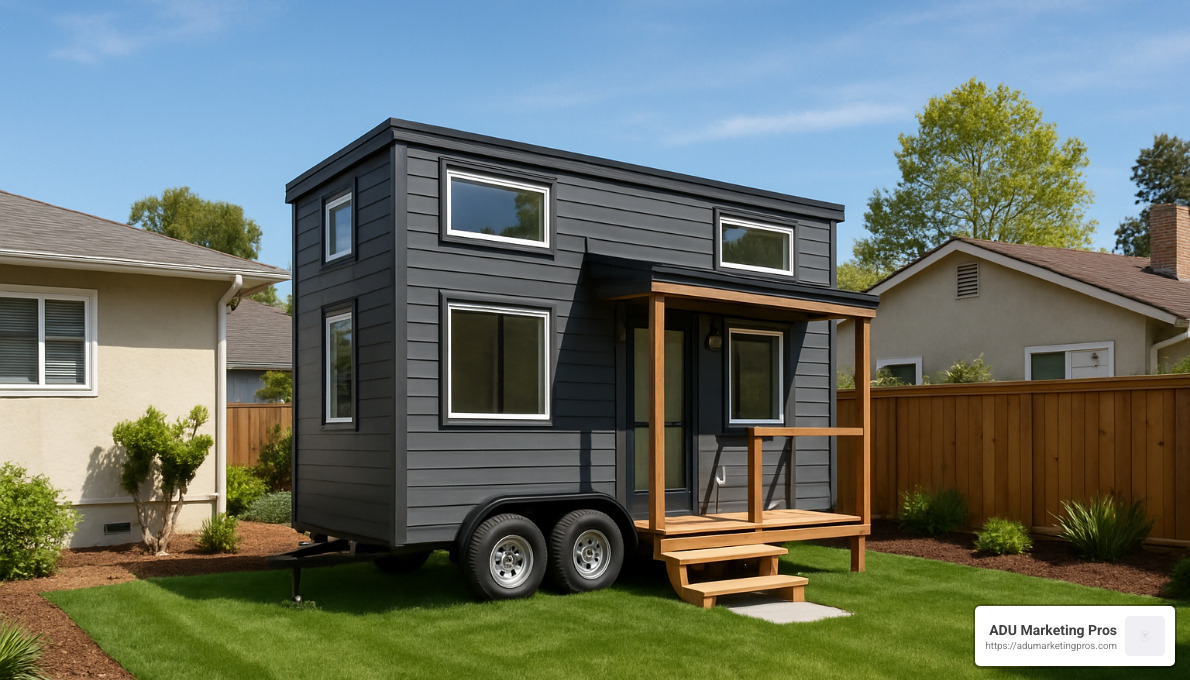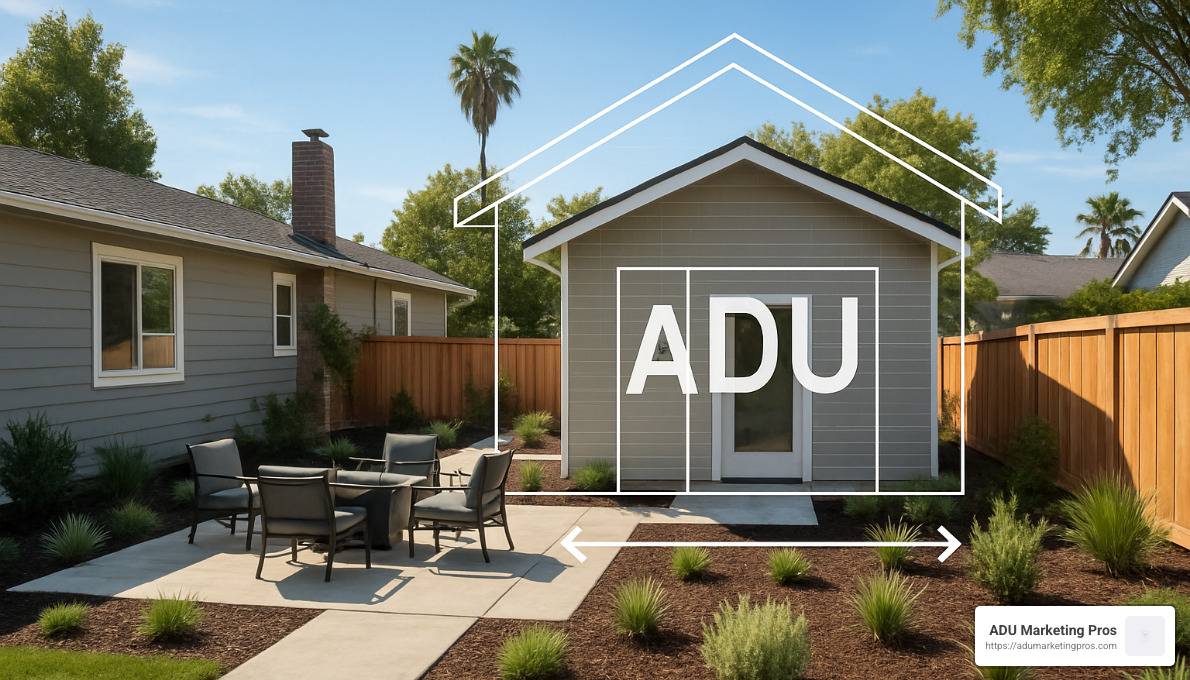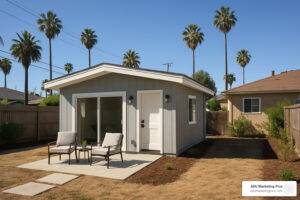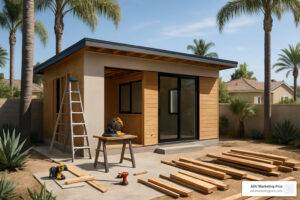Navigating San Jose’s ADU Revolution
The backyard revolution is here! San Jose ADU guidelines have transformed how homeowners think about their property’s potential. These comprehensive regulations govern everything about Accessory Dwelling Units in California’s third-largest city, opening doors to new housing possibilities.
For those who love a quick reference, here’s what you need to know at a glance:
| Key San Jose ADU Guideline | Specification |
|---|---|
| Allowed Zones | R-1, R-2, R-M, PD, and specified mixed-use designations |
| Maximum Size | 1,000 sq ft (lots <9,000 sq ft); 1,200 sq ft (lots ≥9,000 sq ft) |
| Height Limits | 18 ft (one-story); 24 ft (two-story) |
| Minimum Setbacks | 3 ft (side/rear); 45 ft (front for detached) |
| Units Allowed | Single-family: 1 ADU + 1 JADU; Multifamily: 2 detached + up to 25% of units as attached |
| Minimum Size | 150 square feet |
ADUs are blooming across San Jose neighborhoods like wildflowers after spring rain. The city issued over 2,200 ADU permits in 2024 alone—a remarkable 20% jump from the previous year. This isn’t just a trend; it’s a movement reflecting California’s creative approach to addressing its housing crunch.
Are you a homeowner dreaming of generating monthly rental income? Perhaps you’re an architect sketching innovative small-space designs, or a builder wanting to expand your portfolio. Whatever your connection to ADUs, understanding San Jose’s regulations isn’t just helpful—it’s essential for your project’s success.
Throughout this guide, we’ll walk together through everything you need to know about building an ADU in San Jose. We’ll explore zoning requirements that determine where you can build, size limitations that shape your design possibilities, and the nuts and bolts of the permitting process. You’ll learn the important distinctions between standard ADUs, Junior ADUs (JADUs), and those increasingly popular Tiny Homes on Wheels (THOWs).
As the City of San Jose notes in their latest guidelines, “With recent updates to California’s ADU laws, San Jose is a great place to build an ADU and allows you to add significant value to your property.” We couldn’t agree more!

Who This Guide Helps
We’ve created this resource with several people in mind, and chances are, you’re one of them!
If you’re a homeowner considering adding an ADU to create rental income, accommodate family members, or boost your property value, you’ll find practical insights throughout these pages. The kitchen table conversations about whether an ADU makes sense for your family start with understanding what’s possible.
For architects designing these unique spaces, we dive into San Jose’s specific requirements that will shape your creative vision while ensuring compliance. Your pencil sketches need to align with code realities.
Builders and contractors will appreciate our straightforward breakdown of permitting processes and construction standards. We know you’re looking for clarity to help projects run smoothly from foundation to final inspection.
Property investors evaluating the ROI potential of ADUs will find valuable context about the San Jose market. Smart investment decisions start with solid information.
And if you’re a real estate professional advising clients about their options, this guide provides the factual foundation you need to give informed guidance about ADU feasibility.
Whoever you are, we’re glad you’re here. Let’s open up the potential of your property, one square foot at a time.
Understanding ADU, JADU & THOW Options
Looking to add living space in San Jose? You’ve got options! The San Jose ADU guidelines recognize several types of accessory dwelling units, each designed to fit different needs and property situations.
Standard ADUs
These are complete homes in miniature—independent living units with their own kitchen, bathroom, living space, and separate entrance. You can build them in three main ways:
As detached ADUs, standing separate from your main house like a backyard cottage. These offer the most privacy for both you and your tenants or family members.
As attached ADUs, which connect to your primary home while maintaining separate living spaces. These typically share at least one wall with your existing house, making them more energy-efficient.
Or as conversion ADUs, where you transform existing space—like your garage, basement, or attic—into a livable unit. These often cost less since the basic structure already exists.
Junior Accessory Dwelling Units (JADUs)
Think of JADUs as the compact cousins in the ADU family. Limited to 500 square feet, these cozy units must be created entirely within your existing home’s footprint, including space in attached garages.
“My JADU gave my mother-in-law independence while keeping her close by during her recovery,” shares one San Jose homeowner. “The smaller size was perfect for her needs.”
JADUs require an efficiency kitchen with limited appliances and a separate entrance. The bathroom is flexible—you can include a private one or share with the main house, making these units incredibly adaptable to your specific situation.
Tiny Homes on Wheels (THOWs)

For those seeking flexibility, San Jose classifies THOWs as a type of ADU with a streamlined permitting process. These mobile units sit on a chassis and can only be placed on single-family properties. They’re subject to specific permit requirements but offer a unique solution that often comes with lower upfront costs.
Here’s how these options compare:
| ADU Type | Size Limit | Location | Kitchen/Bath | Parking Req. |
|---|---|---|---|---|
| Standard ADU | 1,000-1,200 sq ft | Detached or attached | Full kitchen & bath required | May be exempt |
| JADU | Max 500 sq ft | Within existing home footprint | Efficiency kitchen, bath optional | Exempt |
| THOW | Varies | Single-family lots only | Must have facilities | May be exempt |
Benefits & Drawbacks
Adding an ADU to your property comes with some wonderful benefits. Many homeowners enjoy the rental income these units generate in San Jose’s competitive housing market—often $2,000-$3,500 monthly depending on size and location.
ADUs excel at supporting multigenerational living, giving parents, adult children, or other family members their own space while keeping them close. They’re perfect for aging-in-place scenarios where elderly relatives need proximity but also independence.
Your property value typically increases more than the construction cost, making ADUs a solid investment. Plus, you’re helping address San Jose’s housing shortage with a practical solution.
Of course, there are challenges too. Construction costs typically run between $100,000-$350,000 depending on size and finishes. The permitting process can be complex, though recent reforms have streamlined it considerably.
Privacy can become an issue with multiple households on one property, and you’ll need to consider the maintenance responsibilities that come with an additional structure. Some neighborhoods may also raise concerns about parking, noise, or increased density.
ADU vs JADU vs Tiny Homes on Wheels
Under the San Jose ADU guidelines, each housing option serves different needs:
Standard ADUs offer the most flexibility in size and location but come with higher costs and more stringent requirements. They’re essentially complete homes with full kitchens and bathrooms.
JADUs provide an affordable option since they use existing space within your home. Limited to 500 square feet, they require only minimal efficiency kitchens and can share bathrooms with the main house.
THOWs stand out with their mobility and streamlined permit process. As one San Jose homeowner who installed a THOW noted, “The simplified permit process saved us thousands in fees and months in approval time.”
The San Jose ordinance aligns with California state law while adding local specifications that work for our unique community. Whether you’re looking to generate income, house family members, or create flexible living arrangements, understanding these options is your first step toward a successful ADU project.
For more detailed information about navigating the permitting process, check out our guide on ADU permits in California.
Eligibility, Zoning & Lot Requirements in San Jose
Thinking about building an ADU in San Jose? Before you start sketching floor plans or shopping for fixtures, you’ll need to make sure your property actually qualifies under the San Jose ADU guidelines. Let’s walk through what makes a property eligible—and what might throw a wrench in your plans.
Qualifying Zones
Good news! San Jose allows ADUs in most residential areas, including:
- R-1 (Single-family)
- R-2 (Two-family)
- R-M (Multiple residence)
- PD (Planned development)
- Certain mixed-use designations
Not sure about your property’s zoning? The City of San Jose offers a handy online zoning lookup tool that takes the guesswork out of the equation. Just enter your address, and you’ll know in seconds if you’re in an ADU-friendly zone.
Property Designations
Your property’s specific location and characteristics might require extra steps or special considerations. Think of these as yellow flags—not deal-breakers, but definitely worth knowing about upfront:
If your home sits in a historic district, you’ll face additional design review to ensure your ADU complements the neighborhood’s character. Properties in geohazard or landslide zones need a Geologic Hazard Clearance, while homes in flood zones A, AE, AH, or AO must incorporate flood-proofing measures.
Be careful about utility easements—you can’t build on these designated areas. And if your property has special setback requirements, these will affect where you can place your ADU.

To simplify this process, grab the city’s “ADU Universal Checklist” (Bulletin #210). This yes/no checklist is a lifesaver for determining if your property meets all the requirements before you invest time and money in designs and permits. It covers everything from tree preservation requirements to geohazard considerations.
Single-Family, Duplex & Multifamily Allowances
How many ADUs can you build? It depends on your property type:
If you have a single-family home, you’re in luck! You can build one standard ADU (either attached or detached) plus one Junior ADU (JADU). That’s right—you can have both on the same lot, potentially creating two additional living spaces.
For duplex properties, you can add two detached ADUs or one attached ADU, but JADUs aren’t permitted.
Multifamily property owners can add attached ADUs totaling up to 25% of existing units (so a 12-unit building could add 3 attached ADUs), plus up to two detached ADUs. Again, JADUs aren’t an option here.
Location & Setbacks
The San Jose ADU guidelines are quite specific about where your ADU can be placed:
For detached ADUs, you’ll need to position them in your rear yard or at least 45 feet from the front property line. They need to maintain at least 3 feet from side and rear property lines for ground floors, and 4 feet for second stories. Keep at least 6 feet of separation between the ADU and your main house. If you’re building a two-story detached ADU, it needs to be at least 15 feet from side and rear property lines overall.
Attached ADUs must share a wall or roof with your main home. If it’s in the front yard, the front door can’t be on the same facade as your primary residence’s entrance. These ADUs follow the same setback rules as your main house.
JADUs must fit entirely within your existing home’s footprint, which can include converting an attached garage. This makes them perfect for homeowners who don’t want to sacrifice yard space.
San Jose ADU Guidelines & Parking
Recent updates to the San Jose ADU guidelines have significantly relaxed parking requirements, making ADUs more feasible for many homeowners.
While the standard requirement is one parking space per ADU, there are several exemptions that might apply to your situation. No parking space is needed if your ADU is within half a mile of public transit, located in a historic district, part of an existing structure, near car-share vehicles (within one block), or in an area where on-street parking permits are required but not offered to ADU occupants.
Here’s a homeowner-friendly change: if you’re converting your garage into an ADU, you generally don’t need to create replacement parking spaces. This makes garage conversions much more practical for many San Jose homeowners.
For more detailed information about the permitting process in California, check out More info about ADU permits.
The San Jose ADU guidelines continue to evolve as the city works to address housing shortages while maintaining neighborhood character. By understanding these requirements early in your planning process, you’ll save time, money, and avoid the frustration of design revisions or permit rejections.
Size, Height & Design Standards
When planning your ADU in San Jose, getting the dimensions right is crucial. San Jose ADU guidelines provide clear boundaries that help your project sail through approvals while ensuring comfortable, livable spaces.
Size Limitations
Your lot size determines how big your ADU can be. For smaller properties under 9,000 square feet, you can build a detached ADU up to 1,000 square feet. Have a larger lot? You get a bit more room to work with – up to 1,200 square feet.
If you’re attaching your ADU to your home, you’ll need to stay within 800 square feet or 50% of your main home’s living area, whichever works better for you. The overall maximum still applies based on your lot size.
Junior ADUs (JADUs) keep things cozy at a maximum of 500 square feet and must fit within your existing home’s footprint – perfect for converting that rarely-used formal dining room or part of your first floor.
No matter which type you choose, all ADUs must be at least 150 square feet – about the size of a small bedroom – to qualify as habitable space.
Height Restrictions
Height limits help ADUs blend nicely into residential neighborhoods. Single-story detached ADUs can reach up to 18 feet, while two-story versions max out at 24 feet. If you’re building both a JADU and a detached ADU, your JADU height is capped at 16 feet.
For attached ADUs, you can generally match your home’s existing height (typically up to 25 feet), creating a seamless architectural flow.

Bedroom Limitations
Bedroom counts are straightforward under San Jose ADU guidelines: smaller ADUs under 850 square feet are limited to one bedroom, while larger units can include two bedrooms. This helps maintain appropriate density while still providing flexible living arrangements.
“The bedroom limits actually make sense for most families,” notes one San Jose architect. “Even with just two bedrooms, we can create fantastic living spaces that work perfectly for aging parents or young adult children.”
Design Requirements
Your ADU should look like it belongs with your main house. San Jose ADU guidelines require compatible design elements – think matching roof forms, complementary window styles, and similar exterior materials and colors. This creates a cohesive property appearance that neighbors will appreciate.
Each ADU needs its own entrance, providing privacy and independence for occupants. You’ll also need to comply with California Building Code and energy efficiency standards. If your main house has fire sprinklers, your ADU will need them too – safety first!
Rear-Yard Coverage & Open Space
San Jose values green space, which is why the “Rear Yard Coverage Rule” exists. All structures in your backyard – including your ADU, shed, and that hot tub gazebo you’ve been dreaming about – can’t cover more than 40% of your rear yard or 800 square feet, whichever is greater.
This thoughtful limitation preserves outdoor living space and prevents properties from feeling cramped. It also helps maintain the neighborhood’s character while supporting environmental benefits like natural drainage and urban cooling.
Bedroom, Kitchen & Bath Minimums
To qualify as an independent living space, your standard ADU must include the essentials. You’ll need at least one habitable room for living and sleeping, a proper kitchen with a sink, food prep counter, and permanent cooking facilities (a range or cooktop not exceeding 120V).
A separate bathroom with toilet, sink, and shower or bathtub is required, along with adequate storage space for residents. JADUs follow simpler guidelines, requiring just an efficiency kitchen with limited appliances, and they can even share bathroom facilities with the main house.
These requirements ensure every ADU provides true independent living while maintaining flexibility in how you configure your space. Whether you’re creating a home for aging parents or generating rental income, these standards help create comfortable, functional dwellings that improve San Jose’s housing landscape.
Permitting, Fees & Typical Costs
Let’s face it—the permitting process is often where many ADU dreams hit their first major hurdle under San Jose ADU guidelines. But don’t worry, we’ll break it down into manageable steps!
The Permit Process
Think of the ADU permitting journey as a well-defined path with seven key milestones. It starts with reviewing the ADU Universal Checklist (Bulletin #210)—your roadmap for the entire process. Once you’ve confirmed your eligibility, you’ll submit your application through SJPermits.org by navigating to Building → 1 & 2 Family Detached Dwellings → 2nd Unit Added → New Construction.
All your documents get uploaded through the SJePlans portal, where city staff will review them. Be patient during this stage—plan reviews typically take about 20 business days for the first round. After paying your fees and receiving your building permit, you’ll move into the construction phase with its required inspections. The journey concludes when you receive that coveted Certificate of Occupancy.
“The online portal made tracking our application status so much easier,” shares one San Jose homeowner. “We could see exactly where we were in the process at any time.”
Required Documents
Your application package needs several key forms, and missing even one can delay your project:
Form 310 (Building Permit Application), Form 311 (Owner-Builder Acknowledgement, if applicable), Form 312 (ADU Property Owner Declaration), and Form 313 (JADU Deed Restriction Agreement, for JADUs only). You’ll also need Form 302 for address assignment and a complete plan set following Bulletin #211 guidelines.
Don’t overlook the hydrant flow data letter from your water company—it’s one of the most commonly forgotten requirements that can hold up your permit!
Fee Structure
Building an ADU in San Jose comes with various fees that can add up quickly. Building permit fees typically range from $1,000 to $5,000 depending on your project’s size. Plan review fees are calculated at an hourly rate based on your project’s complexity.
If you need new utility connections, water and sewer connection fees can be substantial—ranging from $5,000 to $25,000. There’s good news for smaller ADUs: school impact fees are waived for units under 750 square feet. For larger units, expect to pay parkland fees between $1,700 and $8,900, varying by neighborhood.
Other potential costs include geological hazard reviews, tree removal permits, and fire variance fees. To avoid surprises, use the City of San Jose’s Building Fee Estimator tool to calculate your potential costs before you start.
Total Project Costs
Beyond the permitting fees, the actual construction represents your biggest investment. In San Jose’s market, detached new construction ADUs typically cost between $200,000 and $350,000. Attached ADUs are somewhat more affordable at $150,000 to $250,000, while garage conversions usually run $100,000 to $175,000. The most budget-friendly option is creating a JADU, which generally costs between $50,000 and $100,000.

Streamlined & Preapproved Pathways
San Jose offers some clever shortcuts that can save you significant time and money. The Preapproved ADU Plans Program features standardized designs already vetted by the city. If your site-specific documents are complete, you could walk away with a permit the same day you apply! This approach typically reduces both design and review costs.
Another time-saver is using factory-built ADU foundations from state-approved vendors. These come in sizes from 330 to 1,200 square feet and can dramatically cut down your design and review timeline.
“Using a preapproved plan saved us nearly two months in the permitting process and reduced our design costs by several thousand dollars,” one happy San Jose homeowner told us.
For more information about navigating the permit process, check out our detailed guide on ADU permits in California. If you’re interested in saving even more time, explore Preapproved ADU Plans in San Jose or visit the state’s official resource on Accessory Dwelling Units and JADUs.
Financing & Tax Impacts
Funding your ADU project offers several paths. Many homeowners tap into their home equity through a HELOC or opt for a cash-out refinance of their existing mortgage. Construction loans designed specifically for ADUs are becoming more common, and some lenders now offer ADU-specific financing options with competitive terms.
On the tax front, be prepared for some changes. Building an ADU will increase your property taxes based on the added value—but fortunately, only the ADU’s value gets reassessed, not your entire property. Any rental income must be reported on your tax returns, and San Jose may require you to pay business tax if you’re renting out your ADU.
For a deeper dive into the financial aspects, see our comprehensive guide on ADU construction costs that breaks down expenses by category and region.
Building, Timeline & Common Pitfalls
Let’s talk about what really happens when you build an ADU in San Jose – the good, the challenging, and everything in between. Understanding the journey ahead helps set realistic expectations so you can plan accordingly.
Typical Timeline
Creating your dream ADU doesn’t happen overnight, but the end result is worth the wait. Here’s what the journey typically looks like:
For the design and permitting phase (4-6 months), you’ll spend about a month in initial planning, another month or two developing your design, and then 2-3 months navigating the permit application and review process.
Once approved, the construction phase (4-6 months) kicks off with 2-4 weeks of site preparation, followed by 2-3 weeks for the foundation. Framing and exterior work usually takes 4-6 weeks, interior finishes another 6-8 weeks, and final inspections typically require 2-3 weeks.
Good news if you’re converting a garage – these projects often move faster, potentially wrapping up in under 9 months total from concept to completion.
As one San Jose homeowner shared, “I wish someone had told me to add a two-month buffer to whatever timeline my contractor promised. Between permit delays and supply chain issues, everything took longer than expected—but the finished ADU was absolutely worth the wait.”
Construction Considerations
Building under San Jose ADU guidelines comes with some unique challenges worth preparing for:
Utility connections often cause headaches for homeowners. Trenching for water, sewer, and electrical lines can be surprisingly disruptive and costly, especially when unexpected obstacles appear underground.
Fire code compliance requires careful attention to details like address numbers, access paths, and hydrant proximity. These seemingly small items can cause big delays if overlooked.
If you’re building a two-story ADU, window sills facing side or rear property lines must be at least 5 feet above floor level to preserve neighbor privacy.
Energy efficiency standards under Title 24 are strict in California. Your insulation, windows, and HVAC systems must meet specific requirements that may exceed what you’re used to.
And don’t forget about fire sprinklers – they’re required if your primary residence has them, or for attached ADUs over 500 square feet when the combined area exceeds 3,600 square feet.

Regulatory Considerations
The regulatory landscape for ADUs in San Jose has some important nuances:
Owner-occupancy requirements have evolved in recent years. Following the expiration of the temporary exemption in January 2025, San Jose now requires property owners to live in either the primary residence or one of the ADU units on the property. This is an important consideration for investors planning long-term rental strategies.
If you’re planning to rent your ADU, short-term rentals (less than 30 days) are prohibited in San Jose. This means no Airbnb or VRBO-style arrangements.
Unlike some other cities, ADUs in San Jose generally cannot be sold separately from the primary residence. They’re considered part of the same property.
For safety reasons, your ADU will need its own address assignment for emergency services, which is handled during the permitting process.
Avoiding the Top 5 Mistakes
I’ve seen countless ADU projects hit unnecessary roadblocks. Here are the most common pitfalls and how to avoid them:
Incomplete plans are the number one cause of permit delays. Follow Bulletin #211 precisely and have an experienced professional review your plans before submission. Those tiny details matter!
Many homeowners forget the hydrant flow letter from their local water provider. This seemingly minor document can hold up your entire project, so request it early in the process.
Setback miscalculations happen more often than you’d think. Don’t rely on fences or visible boundaries to measure setbacks – they often don’t align with legal property lines. A professional survey is worth the investment.
Oversizing the ADU can force you back to the drawing board. Calculate size limitations carefully, particularly the rear yard coverage rules, which restrict total structures to 40% of the rear yard or 800 square feet (whichever is greater).
Parking miscounts create unnecessary complications. While many ADUs are exempt from parking requirements, misapplying these exemptions can lead to permit rejection and delays.
As the City of San Jose notes in their permit guidance, “It is highly advised that you have the vendor or contractor pull the permits to keep liability with the professional service.”
Maintenance & Long-Term Management
Once your beautiful ADU is built, you’ll need to shift into landlord mode:
Your landlord duties will include tenant screening, creating solid lease agreements, and handling ongoing maintenance. Being responsive to tenant needs helps maintain a positive relationship.
Don’t forget about business tax – San Jose requires business tax registration for rental properties, which is a simple but mandatory process.
Your insurance needs will change with an ADU. Contact your provider to ensure adequate coverage for both the additional structure and the increased liability of having tenants.
Long-term leases with minimum 30-day rental periods are required in San Jose. This helps maintain neighborhood stability and prevents the revolving door of vacation rentals.
Keep meticulous records of all permits, plans, and construction documentation. These will be invaluable if you ever sell the property or need to make future modifications.
Building an ADU under San Jose ADU guidelines may seem daunting, but thousands of homeowners have successfully steered the process. With proper planning and professional guidance, your ADU project can provide years of additional income or comfortable living space for your loved ones.
San Jose ADU Guidelines FAQs
Navigating ADUs can feel like learning a new language. Let’s break down the most common questions about San Jose ADU guidelines to make your journey smoother.
What is the smallest ADU allowed under San Jose ADU guidelines?
If you’re working with limited space, you’ll be glad to know that San Jose permits ADUs as small as 150 square feet. This aligns with California state requirements and ensures even compact units can function as proper living spaces.
Even at this minimum size, your tiny ADU must include all the essentials: a habitable living/sleeping area, a bathroom with toilet, sink, and shower, a kitchen with permanent cooking facilities, and some storage space. Think of it as a tiny home with all the functionality of a larger dwelling.
As one San Jose homeowner shared, “Our 200-square-foot ADU may be small, but it has everything our college student needs when she visits—and the rest of the year, it’s perfect for my home office.”
How many ADUs can I build under San Jose ADU guidelines?
The number of ADUs you can build depends on your property type:
For single-family homes, you can build one standard ADU plus one JADU—giving you potentially two additional living units on your property.
If you have a duplex, you can add two detached ADUs or one attached ADU, but no JADUs are permitted.
Owners of multifamily properties have the most options: you can build two detached ADUs plus attached ADUs equal to 25% of existing units. For example, if you own a 12-unit apartment building, you could add three attached ADUs plus two detached units.
These are maximum allowances—your specific lot size, configuration, and other factors will determine what’s actually feasible for your property.
Do San Jose ADU guidelines require separate utilities?
San Jose ADU guidelines offer flexibility when it comes to utilities, giving you options that fit your budget and long-term plans.
For water and sewer connections, you can either connect to the main house system or install separate connections. Electrical service can be submetered from the main house or have its own dedicated meter. If you’re using gas, you have similar choices—share with the main house or install a separate meter.
I strongly recommend consulting with PG&E early in your planning process. While sharing utilities with the main house typically costs less upfront, separate meters make expense allocation clearer for rental units. As one local ADU owner noted, “Having separate electric meters has made managing our rental unit so much easier—no more complicated calculations at the end of each month.”
Is owner occupancy required for ADUs in San Jose?
As of 2025, owner occupancy requirements have been reinstated for ADUs in San Jose. The temporary exemption that ran from January 1, 2020, until January 1, 2025, has expired, and property owners are now required to live in either the primary residence or one of the ADU units on the property.
This requirement applies to both standard ADUs and JADUs. If you’re planning to build an ADU, you should be prepared to maintain the property as your primary residence or have a family member occupy one of the units.
The reinstatement of this requirement represents a significant change for property investors who had been operating under the temporary exemption. Be sure to consult with a real estate attorney if you have questions about how this might affect your specific situation.
Can I convert my garage into an ADU in San Jose?
Absolutely! Garage conversions are among the most popular and cost-effective ADU options under San Jose ADU guidelines. Converting your existing garage typically:
- Costs significantly less than building a new detached ADU
- Can be completed faster—often in under 9 months from start to finish
- Doesn’t require you to provide replacement parking spaces
- Makes efficient use of existing structure and foundation
Your converted garage must still meet all habitability requirements, including minimum ceiling height (typically 7’6″), proper insulation, ventilation, and emergency egress windows. Many homeowners find that garage conversions offer the best balance of cost, timeline, and usable space.
How long does the ADU permit process take in San Jose?
The permit timeline in San Jose is relatively predictable, though patience is still required. Typically, you can expect:
Initial plan review takes about 20 business days (that’s roughly a month of calendar time). If corrections are needed, each subsequent review usually takes 10-15 business days. Most projects go through 1-2 review cycles before approval.
The total permitting process averages 2-3 months from submission to approval, though this can vary based on project complexity and how quickly you respond to correction requests.
If you’re in a hurry, consider using preapproved plans, which can receive same-day permits if all your site-specific documents are complete and accurate. As one local builder told me, “Using the city’s preapproved plans cut our permitting time from three months to just two weeks—it was a game-changer for our timeline.”
For professional guidance on navigating the ADU marketing landscape in San Jose, ADU Marketing Pros can help you connect with qualified professionals who understand these regulations inside and out.
Conclusion
Navigating San Jose ADU guidelines might feel overwhelming at first glance, but I promise—once you understand the key requirements, your project journey becomes much smoother. In recent years, San Jose has worked hard to streamline these processes, reflecting California’s genuine commitment to tackling housing shortages through creative approaches.
If you’re considering an ADU project in San Jose, here’s what you’ll want to keep in mind:
First, verify your eligibility early using the ADU Universal Checklist. This simple step can save you countless headaches down the road by confirming your property meets all the basic requirements before you invest time and money.
Second, take a serious look at those preapproved plans. As one homeowner told me, “We saved nearly three months and several thousand dollars by going with a preapproved design.” The city offers these plans specifically to make your life easier—why not take advantage?
When it comes to budgeting, be realistic about both permit fees and construction costs. Most San Jose ADU projects in 2025 range from $120,000 for simple conversions to $400,000 for custom detached units, plus $1,500-$6,000 in permit fees. Having these numbers clear from the start helps prevent mid-project financial stress.
Time is another crucial factor. Most successful ADU projects in San Jose take 8-12 months from initial concept to final inspection. Planning for this timeline helps manage expectations for both you and any potential tenants.
Finally, don’t hesitate to consult professionals familiar with San Jose’s specific requirements. Their expertise can steer you through potential pitfalls that might not be obvious to first-time ADU builders.
With over 2,200 ADU permits issued in 2024 alone, San Jose has clearly demonstrated its commitment to expanding housing options through accessory dwelling units. Whether you’re building to generate rental income, create space for family members, or boost your property value, ADUs represent a significant opportunity for San Jose homeowners.
For architecture and construction firms looking to stand out in the growing ADU market, effective marketing becomes essential in this increasingly competitive space. At ADU Marketing Pros, we specialize in helping ADU-focused businesses attract high-quality leads through targeted digital marketing strategies specifically designed for the unique San Jose market.
The ADU revolution in San Jose is really just beginning, and with thoughtful planning and the right guidance, your accessory dwelling unit can become part of this exciting housing solution while creating value for years to come.




